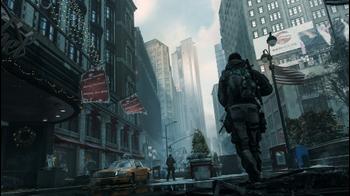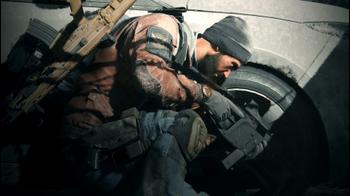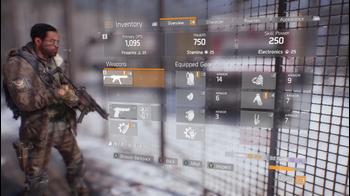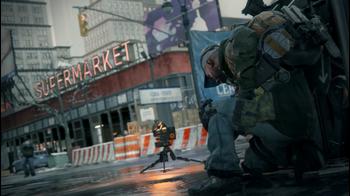
Tom Clancy's The Division Review
The RPG genre has been growing drastically more diverse over the course of the past decade, but titles like The Division perhaps best represent just how far this has gone. Tom Clancy's The Division, which the late Tom Clancy had absolutely nothing to do with, isn't quite a third person cover shooter, stuffed so full with RPG elements that it falls more in that genre than shooter. It's also heavily online-leaning yet isn't quite an MMO either, with the world constantly instanced and missions either grouped up for or matchmade via menus. It's a strange mix.
In 2016 it might be easier to explain The Division another way, though it might be painfully reductive to do so: It's Destiny. While they've arrived too close to each other for Bungie's RPG-shooter hybrid to have been too influential on Ubisoft's attempt at the same genre, it's clear both companies came to similar conclusions almost at the same time. People like shooting things, people like the sense of accomplishment of watching EXP bars climb and in finding new gear, and people also like playing together: so let's combine them.
What you get as a result is an always-connected third person shooter with a heavy dose of Diablo-style loot grind layered on top of it. Loot is colored just as you'd expect it to be, and so statistics-driven is the shooting that when you fire your reality-accurate AK47 at an enemy numbers spew out of them like you're slashing at some alien or hell demon in any other RPG.
The Division's story is simultaneously grounded and ridiculous, the tale of the aftermath when New York becomes contaminated with a deadly virus. With the city quarantined to prevent any further spread of the disease, the survivors are left to forge their own way. You play a member of the titular Division, seemingly normal people who are part of a sleeper cell that's been trained to activate to keep the peace in just such an event. This bit might seem ludicrous, but similar sleeper cells have kinda-sorta actually existed.
Your enemies fall into one of three main factions, and they're all just various types of people. One group are simply looters - they're not very organized, some only wield baseball bats, and though they're killing indiscriminately, they're by no means an organized force. Another group is more deadly, the idea behind them essentially what happens when 'Doomsday preppers' are actually faced with a situation and mobilize all the gear they've accumulated over the years; unlike the hoody-clad looters, these guys are heavily armored and even more heavily armed. Each faction uses clearly different AI tactics too, so enemies aren't just made more difficult by making them able to take more punishment, but also via them making smarter tactical decisions.
There's a strange cognitive dissonance to The Division that comes from its setting and its RPG trappings. The needs of the genre demand that enemies drop loot - a new cosmetic item, a new weapon - but there's something strange about blowing away the evil looters you caught rummaging through a corpse as 'good guy' then running up to that same dead looter to, well, loot him.
The same is true of the enemy design - there's nothing wrong with only facing real people, but having to pump 100 rounds into a boss character does feel somewhat at odds with the grounded setting the game has - a problem that games like Destiny or Borderlands, where you battle aliens or enemies with futuristic shields, don't have. There are of course places they can go - the upcoming raids aren't going to add giants or sorcerers, but what happens if the looters somehow get their hands on a tank? The Division has some scope there, at least.
Despite all this it must be said that The Division does some great work building its world. I'm still confused as to the time frame of when this takes place as the condition of the world makes it seem like much more time must've passed than the game suggests, but given that after its opening missions the game is extremely light on story a lot of great work is done through environmental storytelling. This is actually one of the game's best stand-outs - there's something rather beautiful about this semi-ruined, semi-realistic New York. The game also deftly dodges another pitfall - where many games leave you wondering why exactly there's a sea of chest-high walls and boxes to hide behind, The Division's cobbled-together defense posts and safe-houses look and feel believable, and that's to be commended.
There's less repeated geometry than one has come to expect from such open games, and in a nice touch given that your city is instanced for you whenever you're not in a mission you're able to see it adjust, change and grow as you take back bits of it and restore some order. All of this looks and performs well on all three platforms, though there is some disappointing texture nastiness on both consoles.
While the Division is light on narrative its string of core story-based missions are satisfying, fun, and varied in location. The objectives do all boil down the same basic thing - kill these guys, defend this NPC or this position, retrieve this item - but it still offers up imaginative encounters and takes you through some great-looking and unique locations, some of which have been lovingly based on real-life landmarks.
This mission design is backed up by solid shooting action. Ubisoft has made a lot of shooting games over the years and it shows, with the only material difference here being that enemy damage given and received is of course determined by good old RPG stats under the hood. The different forms of AI feel smart and differentiated enough to make a difference, especially on higher difficulty levels.
All of this is designed to be played in groups; this is not a game that's designed to solo, requiring an online connection even for that. Missions have multiple difficulty levels, and the game expects you to grind out levels by experiencing the same missions more than once with improved AI and enemy stats. The idea is to play through on normal then hit it again for a greater challenge when you understand the mission structure, and for a game that's more about the experience of character growth it works. The Division's narrative is framing for its action, not its raison d'etre.
It's unfortunate that the side content on offer at least in the launch period is lacking and worse still incredibly repetitive. Side missions are a vital staple of any RPG, but what's on offer here is severely lacking. The Dark Zone thankfully helps to make up for this at least in part and forms the game's Player versus Player offering. The zone is part of the map that's sectioned off from the rest for some lore-based excuse, but what makes this section of the city different is that it isn't instanced, so once you enter alone or in a squad you'll see other players. The strongest enemies and the best loot are here, with the aim being to grab loot and safely extract from the zone to take it back to the main game.
There's a catch - if you die, you drop the stuff you've picked up, and other players can choose to gun down their Division allies at any time. If you pick up something good, you might want to watch your back - somebody friendly might decide they value what you're carrying more than your friendship. Attacking an ally marks you as 'rogue', putting a target on your back for a certain amount of time for all players to see. If you can survive that for a certain amount of time you can blend back into the crowd and saunter away with your stolen gear intact - it's a very cool system.
This area of the map helps to make up for lackluster side missions as it's thankfully by far and away my favorite bit of the game. The tension as you wait for an extraction, unsure if a stranger or even a friend is going to come out of the shadows to try to take you out is palpable - and in addition to all this, AI enemies in The Dark Zone are just as brutal themselves. Compared to the rest of the Division it's a complete wild west, but the result of that lawless nature leads to some truly brilliant, heart-pounding moments.
The Dark Zone is ultimately all about gathering loot, and now is a good time to talk about that and RPG mechanics in general. There's a player level which governs you overall and beyond that two types of gear. Equipment actually impacts your statistics, while cosmetic stuff is of course just how you look. Weapons generally fall into the typical real-world archetypes, but a level 5 variant of a particular machine gun will of course have a higher DPS than a level 10 version of the same weapon. The loot grind is satisfying, but more satisfying still is getting your hands on new cosmetic gear to differentiate your character - vital, since the actual character creation process is alarmingly limited.
Player skills split into three distinct trees that essentially amount to a sliding scale between tanky and support styles of combat role. These skills are earned via leveling up your Division base, which is split into corresponding areas - upgrading the medical wing with resources you collect will give access to the medical-driven support ability tree, for instance. There's a decent level of nuance to this system, and between the skills, gear and variety of weapons available, it's possible to have a solidly different spread of character builds even if they do all boil back to 'person with a gun' in the end.
In a sense no matter its quality The Division was destined (ahem) to be heavily compared Destiny, though there are some things that the Division absolutely does better, such as the excellent action in The Dark Zone. Some may find its more grounded basis more appealing too. The Division has a solid basis from which to build, and as with many RPGs of this type its post-launch support and the addition of high-level content such as raids will come to define it. What's there is good, and easy to recommend, but not without caveats and a long list of improvements that'll hopefully be made over the coming updates or in future iterations of the series.



